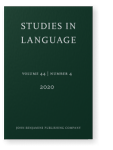Vol. 44:4 (2020) ► pp.812–830
The two faces of animacy
As pointed out by Corbett (2006, 2012), animacy manifests itself in the grammar of languages in two ways: as a feature and as a condition for the realization of other features. In this work I explore this dual behavior by adding further crosslinguistic evidence. I provide examples affecting number, person, case, and gender, and show that, regarding this distinction, they cannot be analyzed in the same way. Moreover, I examine more closely the relation between these manifestations of animacy and show that they can operate simultaneously not only within the same language but also in the same phenomenon. For these cases, I establish a hierarchy between them that can be crossed with the equally hierarchical relation between the animate/inanimate and the human/nonhuman distinction.
Article outline
- 1.Introduction: Animacy effects
- 2.Feature and condition
- 3.Examples of animacy effects
- 3.1Person
- 3.2Number
- 3.3Case
- 3.4Gender
- 4.Animacy: Condition or feature
- 5.The relation of AnimF and AnimC
- 5.1One language, two animacies
- 5.2One language, two animacy splits
- 5.3Two animacies within the same construction
- 6.Conclusions
- Acknowledgements
- Notes
- Abbreviations
-
References
